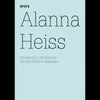Alanna Heiss Die Platzierung des Künstlers(dOCUMENTA (13): 100 Notes - 100 Thoughts, 100 Notizen - 100 Gedanken # 074)
Pressedownload
Der Pressedownload darf nur im Zusammenhang mit einer Buchbesprechung verwendet werden. Für die Illustration einer Buchbesprechung können nur bis zu drei Bilder genutzt werden. Für andere Textformate und Nutzungszwecke (wissenschaftliche Vorträge, Werbung oder ähnliches) bitten wir Sie, vorab mit uns in Kontakt zu treten, um mögliche Fragen zu Honorarkosten, Nutzungsund Urheberrechten zu klären. Die bereitgestellten Bilddaten dürfen nicht manipuliert, beschnitten oder zweckentfremdet verwendet werden. Die Pressebilder dürfen nur mit dem vollständigen Bildtitel, dem Namen des Künstlers und/oder Urhebers sowie mit dem Hinweis auf den Hatje Cantz Verlag veröffentlicht werden. Bitte beachten Sie außerdem im Einzelfall die Reproduktionsbedingungen der VG Bild-Kunst Bonn bzw. der internationalen Verwertungsgesellschaften für Bildende Kunst.
Alanna Heiss
“Placing the artist, not the art”—Alanna Heiss, founder and longtime curator of P.S.1 Contemporary Art Center in New York, reveals her crucial credos in her notebook “Placing the Artist.” According to Heiss, the primary task of a curator is to remain neutral. Against the idea of “curating-as-art,” Heiss highlights the importance of placing the artist and his or her work in the center. The curator’s role is to provide space for the artist to make coherent statements and establish a dialogue with the public. This position comes along with the discretion, help, and carefulness of the curator, who should basically act like a “concierge” (analogous to the commissaire, the French word for “curator”), who works in the background. Alanna Heiss founded and was Director of P.S.1 Contemporary Art Center from 1976 to 2008 and is Director of the Clocktower Gallery and its radio station, ARTonAIR.org, New York.
“Placing the artist, not the art”—Alanna Heiss, founder and longtime curator of P.S.1 Contemporary Art Center in New York, reveals her crucial credos in her notebook “Placing the Artist.” According to Heiss, the primary task of a curator is to remain neutral. Against the idea of “curating-as-art,” Heiss highlights the importance of placing the artist and his or her work in the center. The curator’s role is to provide space for the artist to make coherent statements and establish a dialogue with the public. This position comes along with the discretion, help, and carefulness of the curator, who should basically act like a “concierge” (analogous to the commissaire, the French word for “curator”), who works in the background. Alanna Heiss founded and was Director of P.S.1 Contemporary Art Center from 1976 to 2008 and is Director of the Clocktower Gallery and its radio station, ARTonAIR.org, New York.
“Placing the artist, not the art”—Alanna Heiss, founder and longtime curator of P.S.1 Contemporary Art Center in New York, reveals her crucial credos in her notebook “Placing the Artist.” According to Heiss, the primary task of a curator is to remain neutral. Against the idea of “curating-as-art,” Heiss highlights the importance of placing the artist and his or her work in the center. The curator’s role is to provide space for the artist to make coherent statements and establish a dialogue with the public. This position comes along with the discretion, help, and carefulness of the curator, who should basically act like a “concierge” (analogous to the commissaire, the French word for “curator”), who works in the background. Alanna Heiss founded and was Director of P.S.1 Contemporary Art Center from 1976 to 2008 and is Director of the Clocktower Gallery and its radio station, ARTonAIR.org, New York.





